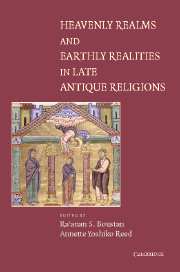Book contents
- Frontmatter
- Contents
- Preface
- List of Contributors
- Introduction: “In Heaven as It Is on Earth”
- PART ONE BETWEEN EARTH AND HEAVEN
- PART TWO INSTITUTIONALIZING HEAVEN
- 6 Earthly Sacrifice and Heavenly Incense: The Law of the Priesthood in Aramaic Levi and Jubilees
- 7 Who's on the Throne? Revelation in the Long Year
- 8 The Earthly Monastery and the Transformation of the Heavenly City in Late Antique Egypt
- 9 Contextualizing Heaven in Third-Century North Africa
- 10 Bringing the Heavenly Academy Down to Earth: Approaches to the Imagery of Divine Pedagogy in the East Syrian Tradition
- PART THREE TRADITION AND INNOVATION
- Select Bibliography
- Index
9 - Contextualizing Heaven in Third-Century North Africa
Published online by Cambridge University Press: 14 July 2009
- Frontmatter
- Contents
- Preface
- List of Contributors
- Introduction: “In Heaven as It Is on Earth”
- PART ONE BETWEEN EARTH AND HEAVEN
- PART TWO INSTITUTIONALIZING HEAVEN
- 6 Earthly Sacrifice and Heavenly Incense: The Law of the Priesthood in Aramaic Levi and Jubilees
- 7 Who's on the Throne? Revelation in the Long Year
- 8 The Earthly Monastery and the Transformation of the Heavenly City in Late Antique Egypt
- 9 Contextualizing Heaven in Third-Century North Africa
- 10 Bringing the Heavenly Academy Down to Earth: Approaches to the Imagery of Divine Pedagogy in the East Syrian Tradition
- PART THREE TRADITION AND INNOVATION
- Select Bibliography
- Index
Summary
In the earliest stages of the movement of Jesus' followers, heaven was no issue. They looked out for his speedy return and were in no need of a detailed description of the “life everlasting.” It can, therefore, hardly be chance that the most important texts in the gospels about the afterlife, the story about Dives and Lazarus (Luke 16:19–31) and Jesus' words on the cross to the criminal (“Truly, I say to you, today you shall be with me in Paradise”; Luke 23:43), both occur only in Luke, the youngest gospel. And, indeed, toward the end of the first century, the situation had changed. It had become clear that Jesus would not return within his followers' lifetimes; yet, the persecutions required an elaboration of the afterlife in order to sustain those Christians who were prepared to die for their faith. Given the absence of any authoritative description, it is surprising how early the main features of heaven became accepted in Christian tradition. Nevertheless, the absence of an authoritative tradition also gave scope for individual appropriations of the standard views. We should never forget that precisely in this area there was always room for more idiosyncratic ideas, as the more interesting visions of heaven invariably contain a personal touch.
In my contribution, I present a commentary on one of these more personal pictures of heaven: a vision of a North African martyr in the middle of the third century c.e. Such visions illustrate the ways in which individual Christians had accepted and modified more traditional ideas.
- Type
- Chapter
- Information
- Heavenly Realms and Earthly Realities in Late Antique Religions , pp. 159 - 173Publisher: Cambridge University PressPrint publication year: 2004
- 2
- Cited by



